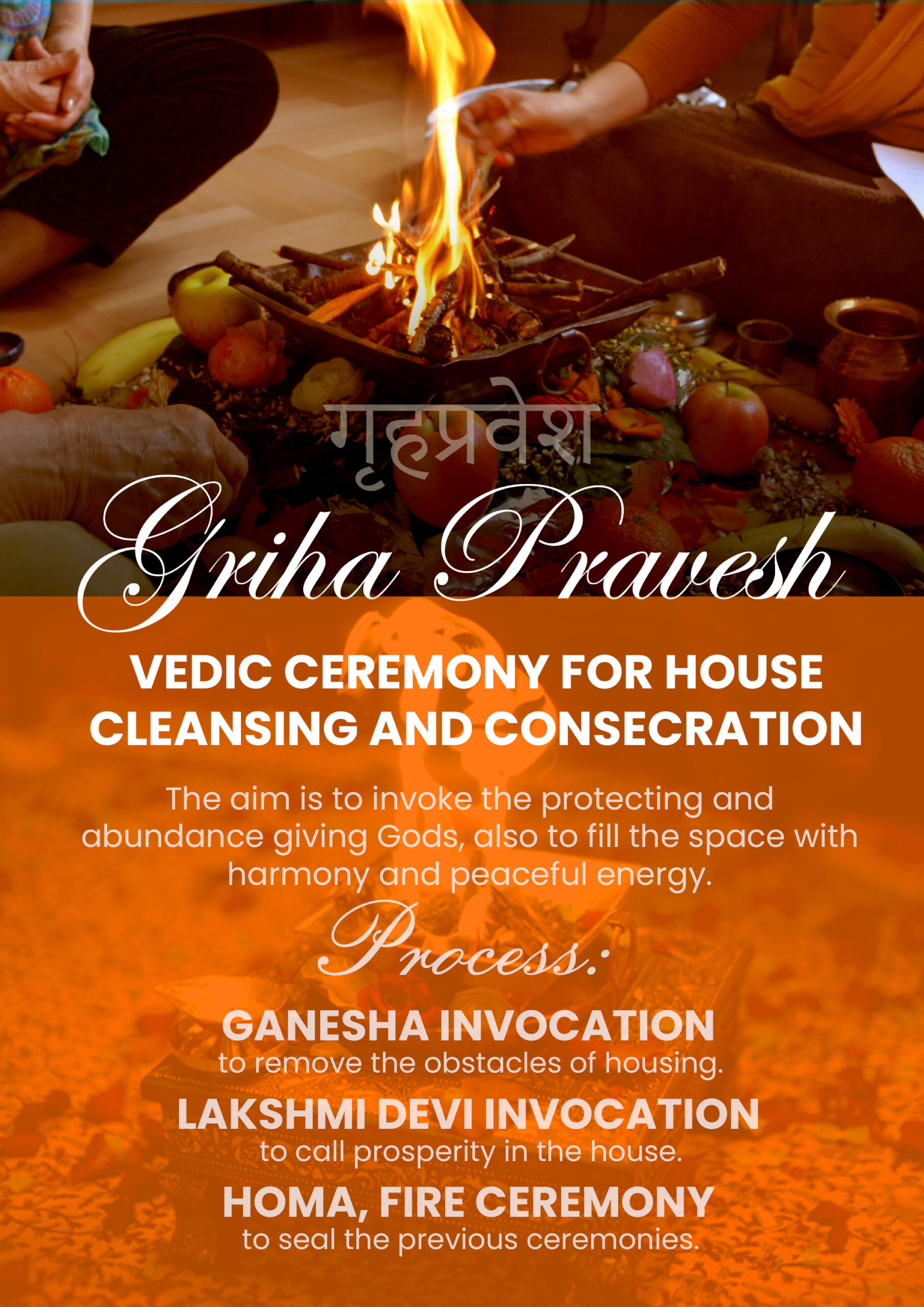Arati
Light offering
HAVAN
Fire Ceremony
SAMSKARAS
Vedic Sacraments
VIVAHA
Marriage
ANTIESTI
Funeral ceremony
GRIHA PRAVESH
House Consecration
ARATI
Offering light to the master principle who has taken shape in a physical body.
Why do we offer light?
The light represents our spiritual consciousness, from which we ask you to guide all our thoughts, words, and actions. We symbolize our consciousness in a physical light and offer it toward an image that represents the principle of the master, with the desire to always be present as a guide in our spiritual development. The flower is a symbol of our most beautiful thoughts and feelings, representing our incense air, our basic vital supporter.
HAVAN
Havan or Homa is a fire ceremony that is central to Vedic culture and religion. We invoke various Deities into the fire through mantras and prayers, thereby making fire a carrier of these forces. During the ceremony we make offerings in the consecrated fire, in the form of ghee, incense, flower, light and ahuti (a mixture of grains and fragrant spices) depending on the intention and occasion. We also call it Yagna, which is we translate to sacrifice, although through the Latin words ¨sacra facere¨ we come closer to the true meaning of what is a sacred act, which we perform with the help of the higher forces of the universe in order to achieve a goal, a higher ideal.
Regular practice of Havan contributes to the expansion of the mind, the purification of the body, the mind and the chakras, and our spiritual transformation, while also having a beneficial effect on our environment. The ceremony is performed once or several times, for example, to heal a sick person, to induce abundance, for children’s naming ceremony, to accompany many Vedic initiations, and to enhance our inner, contemplative lives.
VEDIC SACRAMENTS
Samskaras and ceremonies provide a solid foundation for dharma life.
Their goal is to make them aware of the beauty of the next stage of life, its moral, ethical charge, but at the same time it implements a seed in us in an aesthetic way, it makes us noble and equips us with social values. The sixteen samskara weave through our lives from conception to leaving the body.
- Garbhadana: The conception of new life.
- Punsavana: In the third month after conception, it serves to protect, develop and strengthen the fetus.
- Simantonayana: It is a ceremony eighth month after the conception that strengthens the minds of the mother and fetus, preparing them for birth.
- Jatakarma: The birth where the father is involved in various functions.
- Nāmakarana: Name giving.
- Niskramana: The introduction of the newborn to the forces of nature.
- Annaprasana: Consumption of the first solid bite.
- Chudakarma: The haircut, shaving the hair for the first time.
- Karnaveda: Ear piercing.
- Upanayana: Placing of the sacred bond, yagnopavita.
- Vidjarambha: Beginning of Vedic Studies.
- Samavartana: End of basic Vedic studies.
- Vivaha: Vedic wedding, blessing.
- Vanaprastha: Retreat from social obligations.
- Sannyasa: Resignation. Preparing for the last stage of life.
- Antyesti: The last sacrament, funeral.
VIVAHA VEDIC MARRIAGE
It is created as a sacred union of two people according to the Vedic traditions, which many call marriage, but it is based on cosmic laws and advanced ancient practices. This is considered a saṁskāra, which is a lifelong commitment of the wife and husband. It contains beautiful aesthetic elements which symbol system hides deep ethical and moral values. In India, it is thought to have been designed by the cosmos and is considered “a sacred unity that the fire itself bears witness.”
ANTYESTI
Antyeṣṭi literally means the last sacrifice, the main element of which is the performance of a set of sacred funeral rites and ceremonies. Hindu funeral rites can be divided into four groups:
- Rituals performed when a person is lying on the cot.
After the dead had been washed with consecrated water,
the body is dressed, laid or seated in new clothes,
the forehead is painted with holy ashes (bhasma),
Ganges water is dripped on the lips, tulsi leaves are placed
on the right side of the body. The body of the dead are usually
covered with daisies, decorated with roses, jasmine flowers
and jewelry. Next to the body oil lamp burns for three days. - Cremation or burial rites.
Cremation is the most common form of burial, usually at a
riverside incinerator (shmashana) is performed, and it is
believed that this is how the soul is liberated from the body.
One of the relatives after cremation returns to the scene to
collect the ashes in an urn or throws them into a sacred river (Ganges). - Supporting rites for the departing soul to help the spirit to
migrate to the plane of ancestors (pitris).
The pretakarma rite facilitates this progress. According to
the belief, if these rites are missed or are carried out incorrectly,
the soul of the dead is stuck as a bhuta on this plane. - Rites performed in honor of the ancestors (Pitris)
The rites take place in 10-11 days, by the end of which the
soul is already wandered into the world of ancestors.

CONTACT
Abhinavagupta Dham, Leányfalu
Tel: +36 70 779 2135
Email: hungarysangha.vfs@gmail.com
FOLLOW US!
REGISTRATION NUMBER IN HUNGARY:
01-09-0000083

